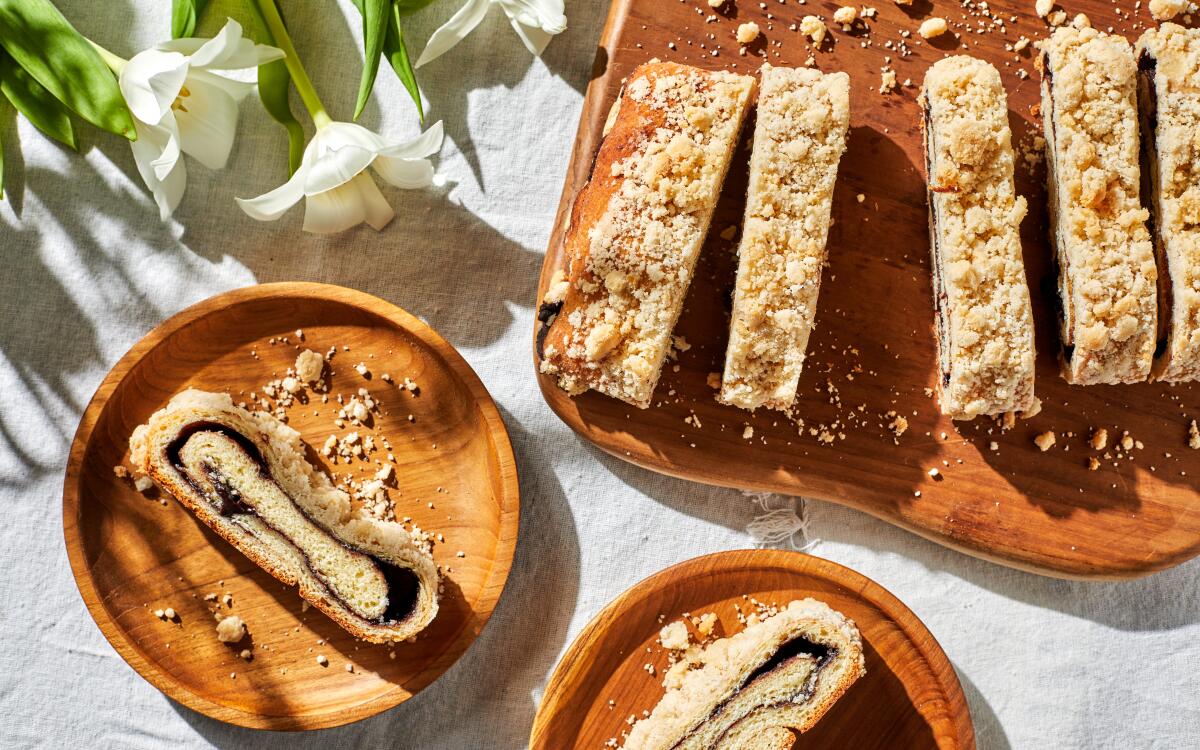Extra-Crumb Kokosh Cake

- Share via
Tender dough, a pleasantly bitter cocoa filling and lots of crunchy crumbs on top make up this kokosh, the old-school Hungarian Jewish precursor to the modern babka. A soft dough, which can be made with margarine to keep it kosher, is folded around a filling of cocoa powder and sugar that melts in the oven to create an intensely chocolate syrup-like filling for the yeasted cake. Traditional recipes use very little to no crumb topping, but this one has a lot to add plenty of crunch, which contrasts with the soft cake underneath. Serve it as a sweet treat or dessert for breaking the Yom Kippur fast or for breakfast or an afternoon snack anytime with a cup of coffee or tea.
Make the dough: In the bowl of a stand mixer fitted with a dough hook, combine the water and 1 teaspoon sugar and stir to dissolve the sugar; this also helps cool the water down slightly. Stir in the yeast, then let stand until foamy, 10 minutes. Add the flour, the remaining ¼ cup sugar, orange juice, salt and eggs. Turn on the mixer to the lowest speed and start a timer; mix until the dough comes together, 1 minute. Increase the speed to medium and continue mixing the dough for 3 minutes.
With the mixer still running, add 1 tablespoon softened butter or margarine to the dough and let it continue to mix until the butter is absorbed, 1 minute; repeat this process seven more times, adding another tablespoon of softened butter each minute to use up 8 tablespoons of the butter total. At the 12-minute mark, the last of the butter should be absorbed. Turn off the mixer and scrape down the side and bottom of the bowl with a silicone spatula to ensure the dough is evenly mixed. Cover the bowl with a kitchen towel or plastic wrap and let it stand until doubled in size, 1 hour.
Meanwhile, make the filling: In a medium bowl, whisk together the sugar, cocoa powder, vanilla extract and salt until evenly combined. The vanilla and cocoa powder may clump a bit at first, but keep whisking and breaking up the clumps until the mixture is mostly smooth.
Make the crumb topping: In a medium bowl, combine the flour, sugar, butter or margarine and salt and knead the mixture with your fingers until it forms uniformly even and sandy clumps. Place the crumb mixture in the refrigerator to keep cold until ready to use.
Heat the oven to 350 degrees F. Line a rimmed baking sheet with parchment paper.
Dust a clean work surface liberally with flour. Divide the dough in half and place one half on the work surface. Using a floured rolling pin and your hands, flatten and gently coax the dough into a 16-by-10-inch rectangle, positioning the rectangle so one of the short sides is closest to you. The dough will be slightly sticky, but try not to use any more extra flour than is necessary. Sprinkle half the filling evenly over the dough, spreading it fully to the edges on all sides except the edge of the short side furthest from you; leave ½ inch of that side exposed.
Visualize that the rectangle will be divided crosswise into quarters. Working with the side closest to you, lift up one quarter of the rectangle and fold it over so it lays flat, like you’re folding a letter but into quarters and not the classic tri-fold. Repeat this fold two more times, so the loaf comes to rest over the exposed short edge. Gently lift the open edges of the loaf and place it crosswise on one half of the prepared baking sheet. Clean the work surface and repeat this process with the remaining dough and filling to make another flat “roll” and place it next to the first roll.
Melt the remaining 1 tablespoon butter or margarine and brush it evenly over both loaves. Using your hands, sprinkle half of the crumb topping evenly over each loaf, piling it up on top if necessary. Some of the crumb topping may fall off the loaves and onto the baking sheet; that’s OK.
Bake, rotating the baking sheet front to back halfway through, until the exposed pastry is golden brown and the crumb topping is crisp, 30 to 35 minutes. Transfer the baking sheet to a wire rack and let the kokosh cool completely before slicing and serving.
Get our Cooking newsletter.
Your roundup of inspiring recipes and kitchen tricks.
You may occasionally receive promotional content from the Los Angeles Times.









